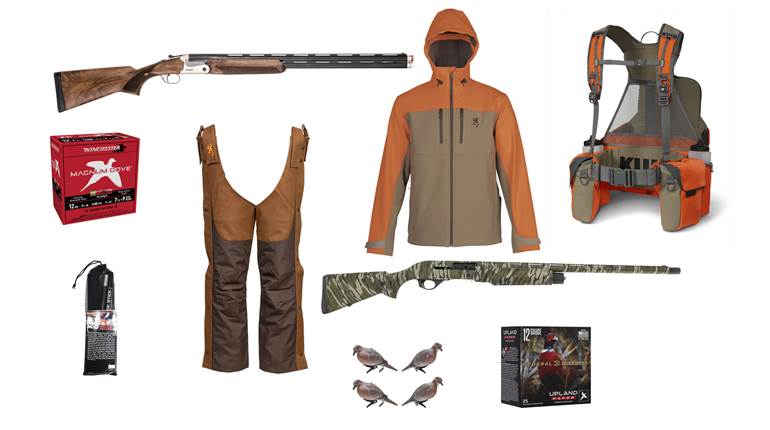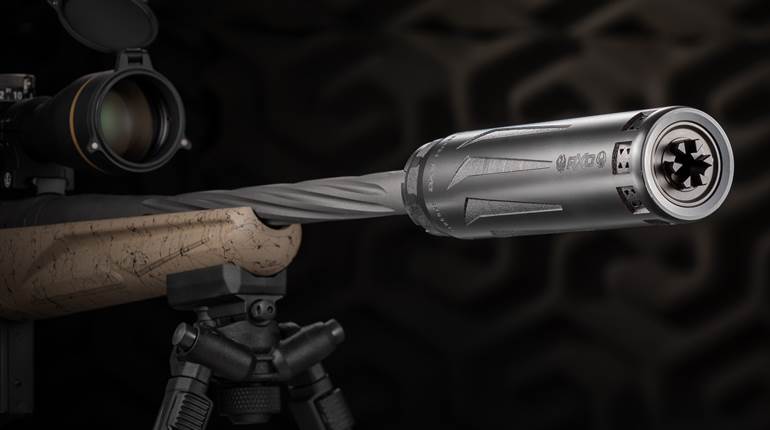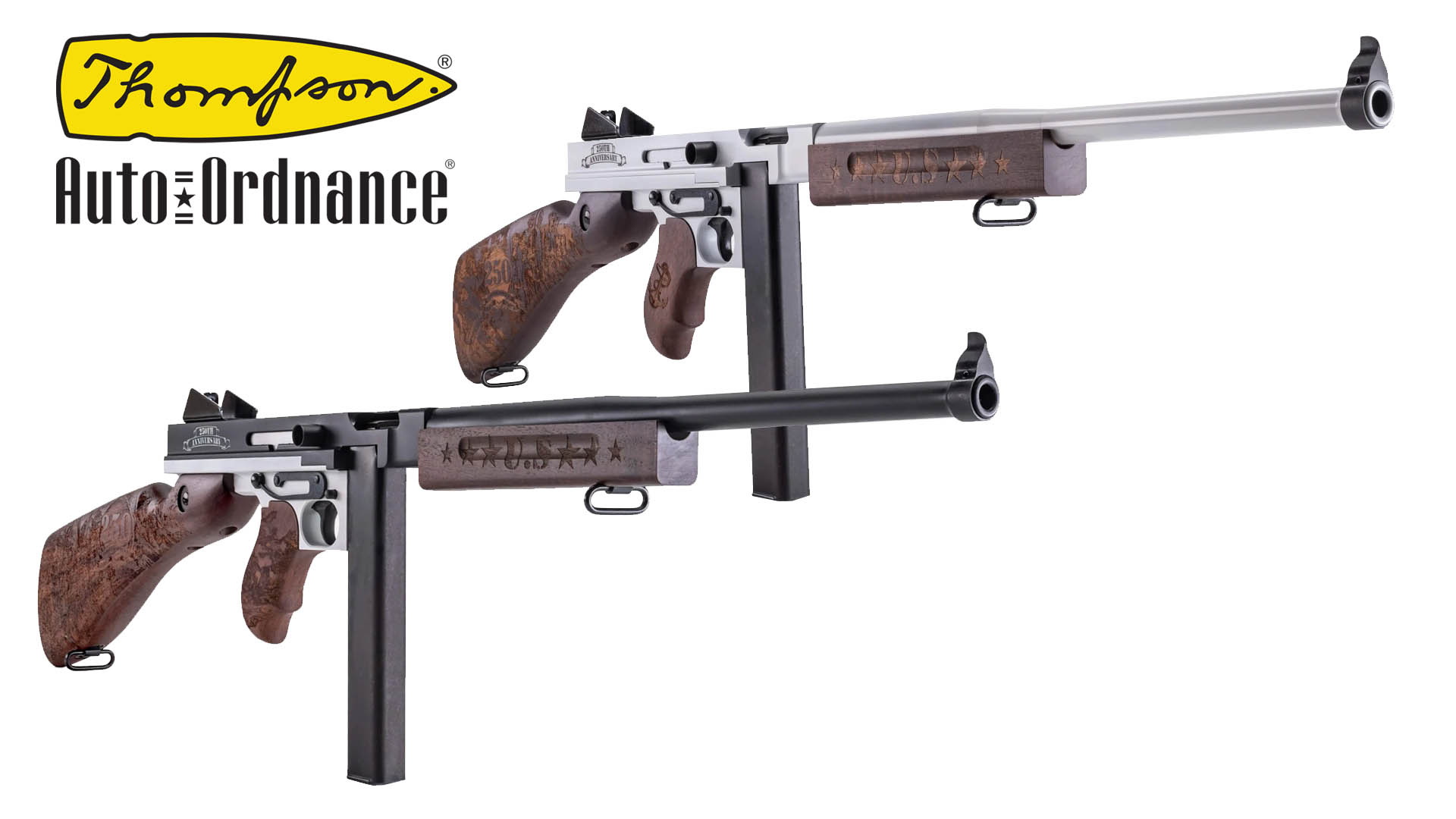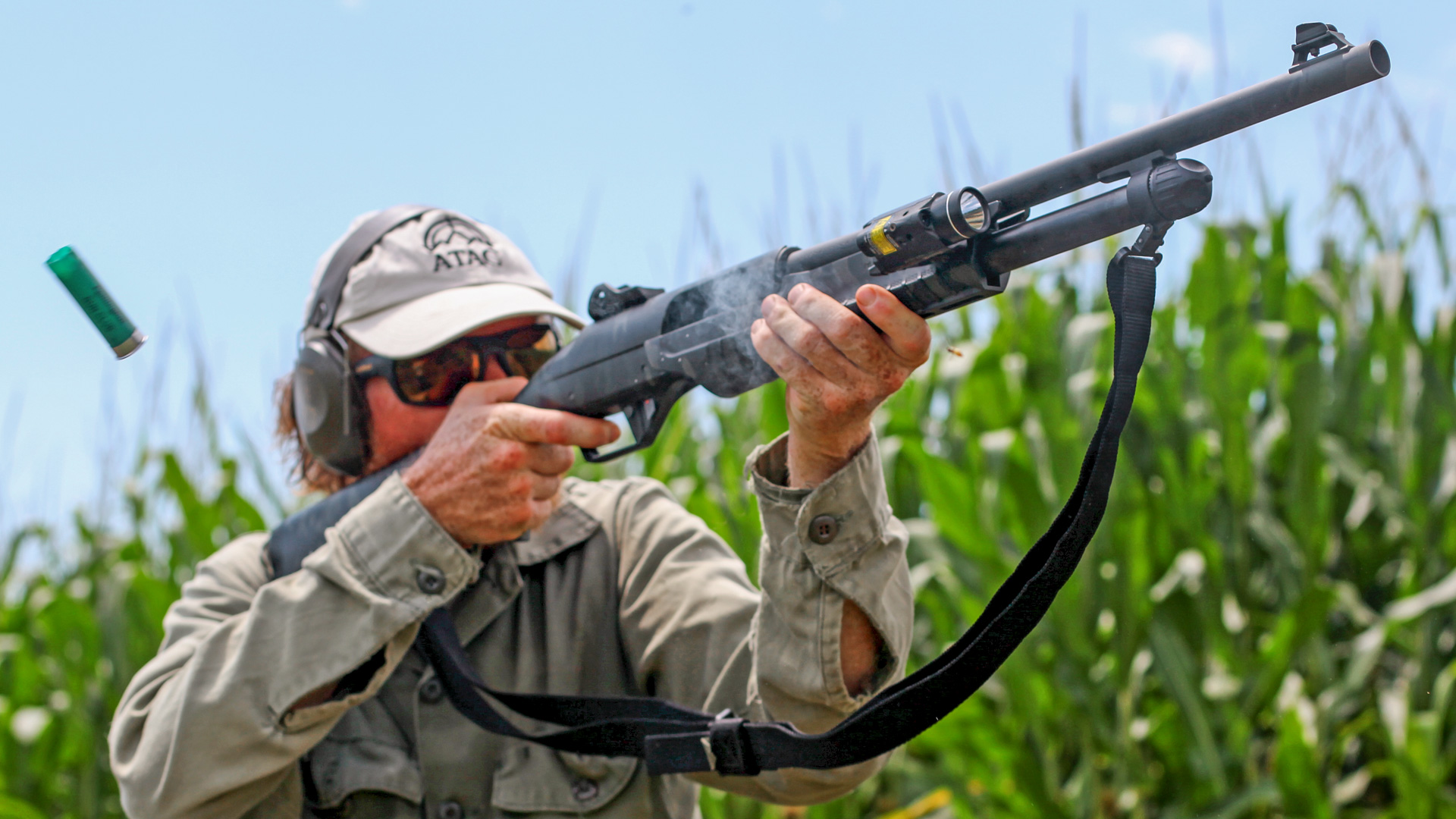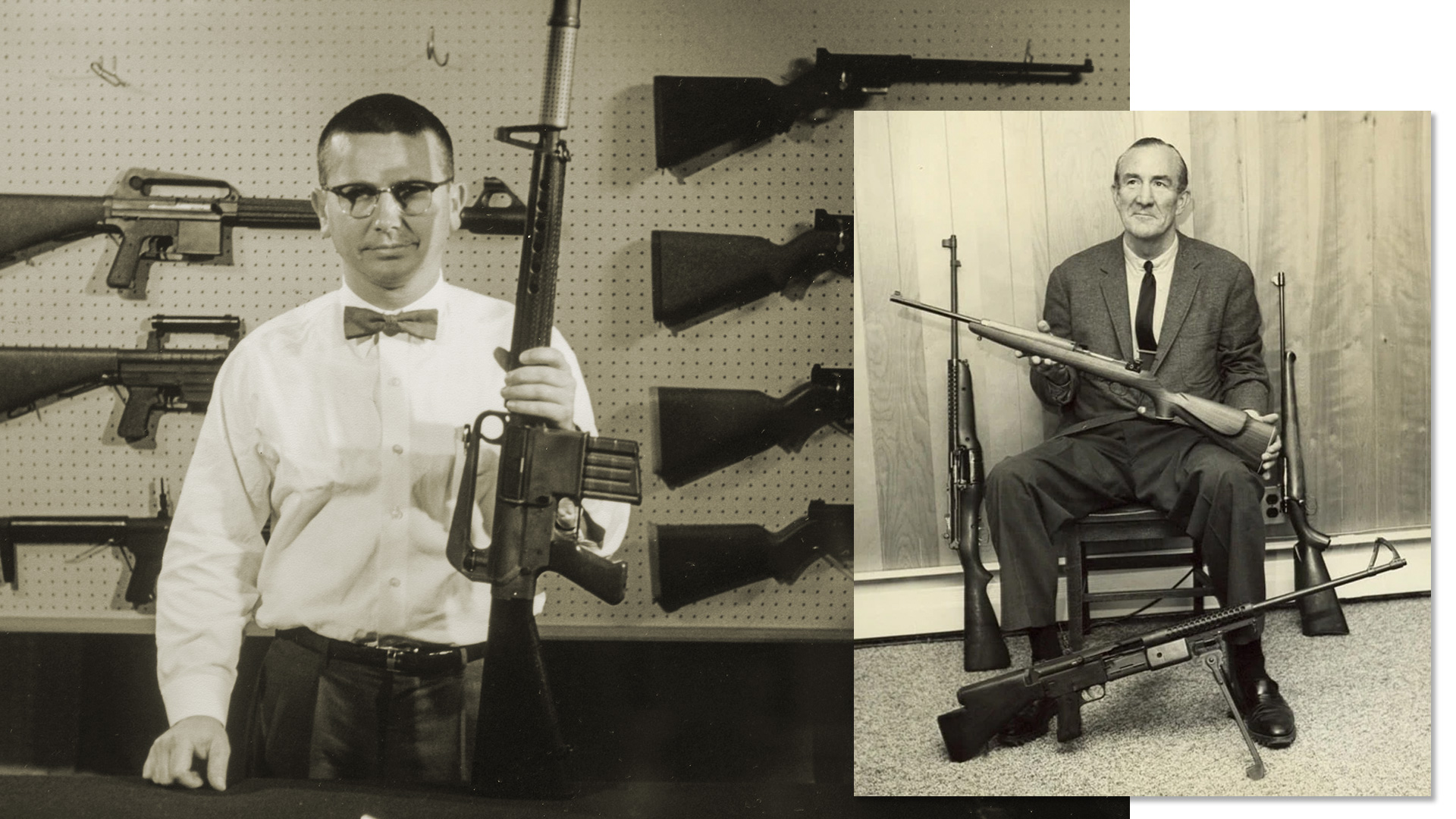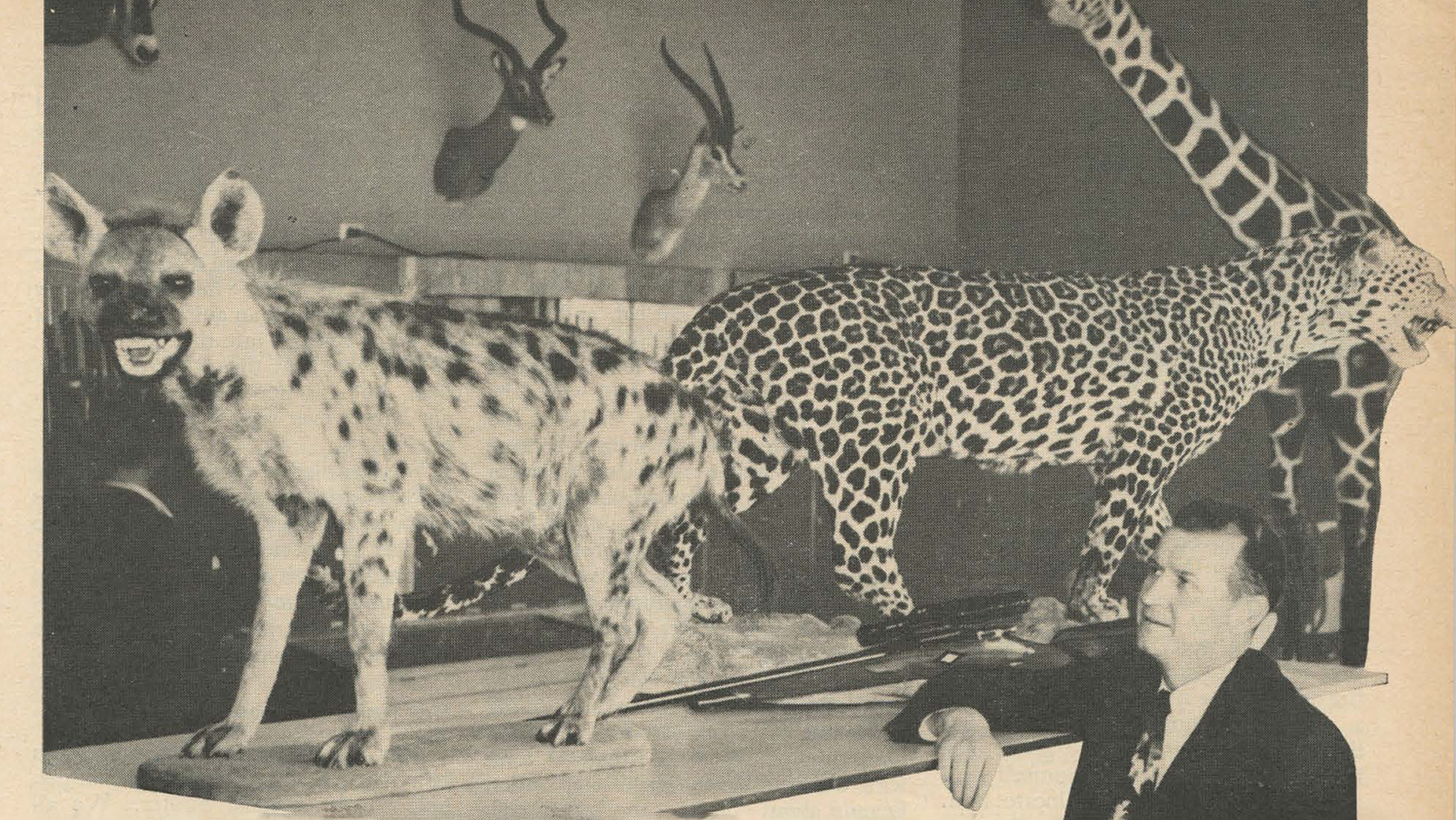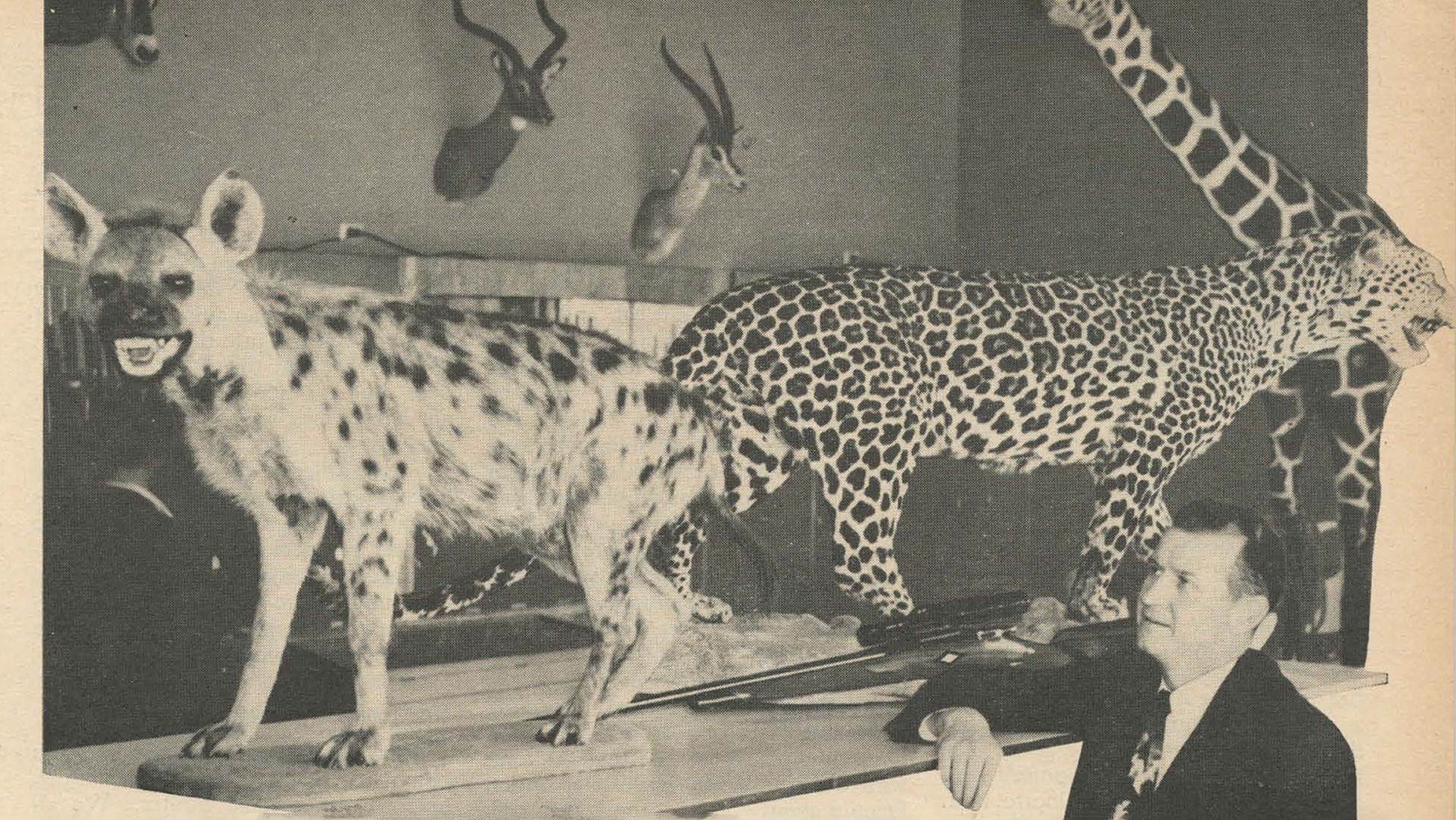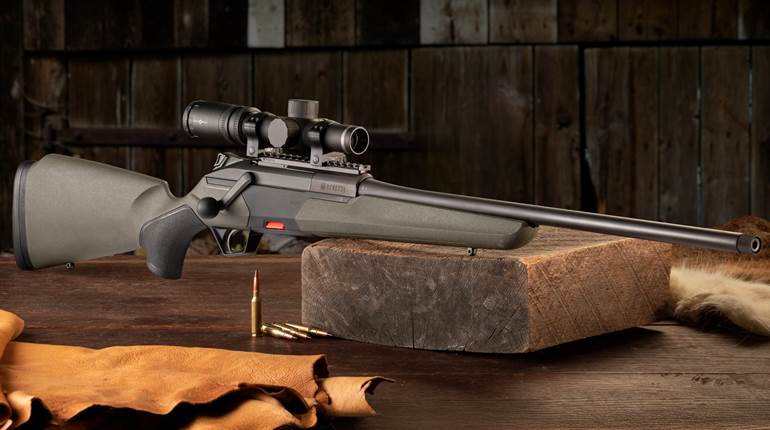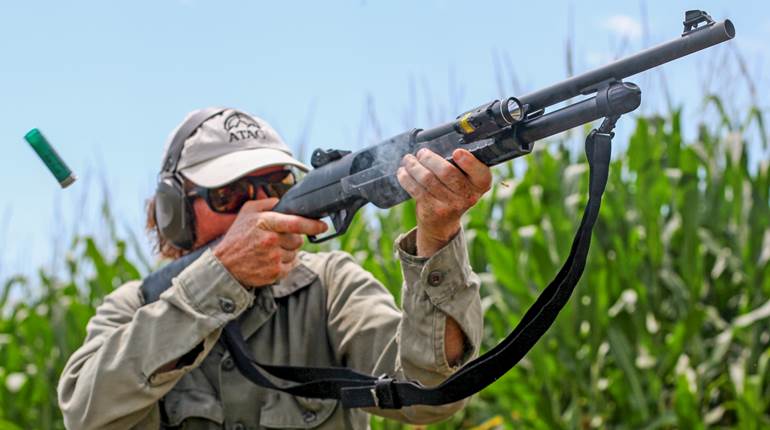
With a range of chamberings from .22 Long Rifle to .270 Win. to 12 gauge to .380 ACP, Browning-branded offerings have come to the market in a big way in order to capitalize on a brand loyalty that would be the envy of any company in any industry.
When Browning announced earlier this year that it was getting into the ammunition business, a few questions came immediately to our minds: How extensive would the product line be? Where would the expertise come from to produce it? And would it really be any different than the raft of offerings already available from competitive companies? Oh, and how about price?
Soon, through a series of Browning-sponsored hunts and informational meetings, the company provided answers to those questions and many more. In addition, it provided ammunition samples that, not surprisingly, would ultimately reassure us that the company named after perhaps the greatest gun designer and cartridge developer of all time would only enhance its reputation with its newest product line.
It was not, however, Browning’s first attempt to bring ammunition to market. Although many may not remember, Browning-branded ammunition has come and gone through the years in limited runs and chamberings, with the biggest push at marketing a full line occurring in the 1970s, but those efforts were all short-lived. This time, Browning ammunition would comprise center-fire rifle, center-fire pistol, shotshell and rimfire categories, each with a respectable array of bullet styles and chamberings. And, yes, each cartridge—even every round of .22 Long Rifle—would bear the company’s signature Buckmark. Creating such a suite of products from scratch would be a prohibitively expensive and daunting task, of course, so Browning partnered with a corporate relative, Winchester Ammunition, to codevelop, manufacture and supply the new ammunition label to the marketplace. But this would be no simple re-branding of existing Winchester loads. Based in Morgan, Utah, Browning’s careful cultivation of its 125-year-old brand has resulted in fans so fervent that they’re known for a cult-like loyalty. No, the new Browning ammunition line would carry newly developed, specially designed, projectiles in distinctive packaging—all the while benefitting from established quality control and distribution efficiencies.
In the end, rabid Browning fans would finally enjoy the satisfaction of loading ammunition bearing the Buckmark into their Browning firearms. Even better, shooters of any brand affiliation seeking yet another choice in quality ammunition with highly engineered bullets would now find distinctive black and gold boxes bearing the trusted Browning Buckmark on dealers’ shelves all across America—and the price tags affixed to those boxes were likely to be pleasantly surprising.
Early on, the editors decided that Browning ammunition, with such a broad array of offerings in multiple categories, merited team coverage for proper evaluation. Following are our results, which highlight both anecdotal observations from the categories and technical assessments of the performance of select offerings within them. Together, they appear to confirm that Browning Ammunition, one of the biggest new product developments in the shooting industry in some time, is poised to make an indelible mark.

Browning Ammunition
Center-Fire Rifle
By Brian C. Sheetz
There’s a curious story about Browning’s signature symbol, the Buckmark, that isn’t widely known. When then art director Don Bailey designed it in 1977, he didn’t realize, until others pointed it out, that his thick outline of an antlered whitetail buck contained, in its negative space, the image of a doe. The resulting image, depicting both sexes of America’s most popular big-game species, quickly became a cult-classic icon for deer hunters of any stripe, but particularly for those who revered the Browning brand. And it has been inextricably linked with the company ever since.
So imagine the extra significance the Buckmark now takes on as the headstamp for a new line of center-fire rifle offerings available in two different bullet types designed for hunting all North American big-game animals. That first, and arguably most important, bullet is the company’s non-bonded BXR with its Rapid Expansion Matrix Tip, designed especially for thin-skinned varieties such as whitetail, blacktail, mule deer and antelope. It is currently loaded in: .243 Win. (97 gr.) and .270 Win. (134 gr.) along with .30-30 Win., .308 Win., .30-’06 Sprg., .300 Win. Mag. and .300 WSM (155 gr.). For thicker-skinned animals, Browning is offering the BXC with its Controlled Expansion Deep Penetrating Terminal Tip. It is loaded in: .270 Win. (145 gr.), 7 mm Rem. Mag. (155 gr.) and .308 Win. (168 gr.) along with .30-’06 Sprg., .300 Win. Mag. and .300 WSM (185 gr.). Both are visually distinctive offerings in their starkly contrasting black and gold packaging, which, of course, prominently features a Buckmark. Inside, the silver-colored bullets—nickel-plated on the BXR and tipped with solid aluminum on the BXC—and nickel-plated cases with contrasting brass primers are as eye-appealing as they are weather-resistant. When checked on a concentricity gauge, samples from several boxes of BXRs confirmed that their beauty was more than skin deep, with bullet runouts measuring a mere 0.001" on average. In testing, velocities ran, on average, about 200 f.p.s. less from the 22" barrel of a Browning AB3, than those advertised, which are derived from the 24" factory test barrel used to develop the loads.

Last November, I had an opportunity to try out Browning ammunition in the field on a whitetail deer hunt with Western Ranch Outfitters in Nisland, S.D., using the BXR load. It features a somewhat light-for-caliber bullet consisting of a lead core with a thin, nickel-plated brass jacket topped with an aerodynamic tip made of a proprietary matrix of 85 percent copper and 15 percent polymer. Designed to fragment upon impact, the tip leaves a large hollow point at the front of the main projectile, allowing it to expand and transfer its energy to the target.
That is precisely what happened when I took a buck late on the first day with some of the earliest Browning-branded rounds to come off the production line. Shooting from a ground blind, I grunted to stop the animal in its tracks as it was passing in front of me about 130 yds. distant. When I pressed the trigger on the .270 Win.-chambered Browning AB3 Composite Stalker, the 134-gr. BXR bullet was sent to a point just behind the animal’s right shoulder, causing the buck to lunge into the air, run straight ahead 20 yds., lunge again and run back to where it had been shot before falling dead. A nearly imperceptible entry hole in a fold of the hide and an approximately 1½" exit hole behind the left shoulder were all the evidence of the kill I could find in the field. Back at the skinning shed, further examination revealed tremendous damage to the nearly 200-lb. animal’s vital organs, with the top of the heart and a
major portion of both lungs essentially pulverized.
The next evening, in a different ground blind and with the end of legal shooting time rapidly approaching, I settled my sights on a 150-lb. doe at about 70 yds. This time, I sent the bullet through the shoulder, which again caused the animal to rear before it bolted off out of sight toward a nearby creek bottom. Carefully noting its escape route, I was soon tracing its path to the edge of the creek’s bank where, peering over the edge, I found that it had come to rest just inches from the water’s edge. Total distance traveled from the site of the shot was approximately 20 yds., and the immediately visible results were remarkably similar as before. Examination of the internal organs also was the same with the bullet having produced a quick, clean kill. In each case, the duration of the animal’s physical reaction was brief enough that no prolonged tracking sessions would have been required even had I been hunting in dense cover.

While it’s impossible to make a sweeping judgment as to the efficacy of a bullet’s design from only a couple of observations, I can attest that the BXR projectile performed exactly as advertised—a comforting but unsurprising result that was repeated by at least one of my fellow hunters, Rafe Nielsen, communications manager for Browning. Having taken a nice trophy whitetail buck during the same trip, Nielsen informed me that the two whitetails I shot represented the first of their species to fall to the new Browning load in the ever-popular .270 Win. chambering. He then elaborated on the bullet’s construction and purpose: “It’s not a weak bullet, it just opens up faster,” he said, adding that the flat-base 134-gr., .270 load I had used possessed velocity more in line with .30-cal. magnums (an advertised 3060 f.p.s.) but that, when striking soft tissue, its tip fragmented explosively, allowing the remaining large hollow point in the bullet’s lead/antimony core to continue penetrating into the animals’ vital organs. The tapered construction of the jacket covering the core, he added, further controlled the bullet’s rate of expansion.
According to Ben Frank, the brand manager for Browning ammunition who has a background in engineering, “penetration of BXR bullets in 20 percent ballistic gelatin is typically 14" to 16". He added that, “about 60 percent of shots on deer with the BXR pass through the animals,” which was not surprising considering my experience. Additional anecdotal information about the 10 or so other deer taken by the time of my South Dakota hunt were consistent with my experiences, with nearly all animals requiring only one shot, with most bullets passing through and with no animals traveling more than 40 yds. after the shot.

Although I did not have an opportunity to hunt with the heavier-for-caliber, bonded BXC Controlled Expansion Terminal Tip bullet—with its thicker, thermally bonded jacket, solid, anodized aluminum tip and boattail base—my colleague, NRA Editorial Director John Zent, did and had this to say about its observed terminal performance: “Let there be no doubt about how the right ammunition can make the .30-’06 Sprg. the equal of more powerful magnums, as evidenced by the results on two red deer and a fallow deer taken with the BXC in New Zealand. The stags (a bit smaller than bull elk) both did the ‘double-leg-kick’ typical of heart-shot deer and crashed over after abbreviated death sprints. The 185-gr. slug recovered from my animal had transformed into a ‘mushroom’ as picture-perfect as any controlled-expansion bonded projectile I’ve used. Ironically, the bullet recovered from my fallow buck (built like a big whitetail) was far more misshapen, but understandably so since it traversed stem to stern while anchoring him in place.”
Addressing their intended role as tough bullets designed more for penetration than the BXRs, Frank quantified the BXC’s penetration in ballistic gelatin by saying, “They tend to go about 18" to 24".”
Prices on BXR and the somewhat more expensive BXC loads place them well within reach of typical consumers and appear to be running around $27 to $45 per 20-count boxes depending on chambering and retailer.
With its BXR and BXC, Browning appears to have most scenarios for North American or African plains big-game hunting nicely covered. A growing list of chamberings is likely to ensure that the Browning name is a major player in the hunting ammunition market in years to come.
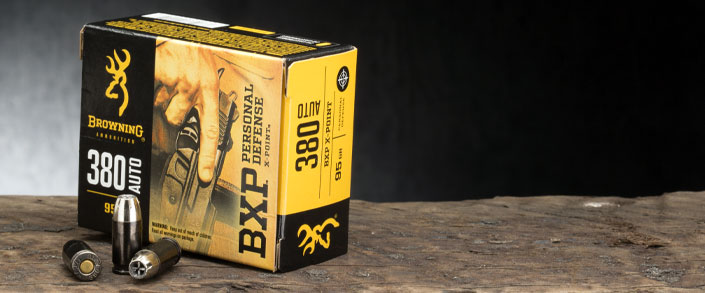
Browning Ammunition
Center-Fire Handgun
By Kelly Young
Browning is coming right out of the gate with two center-fire handgun ammunition lines: the full-metal-jacketed BPT series and the jacketed-hollow-point topped BXP series.
Initially both lines will be offered in today’s four most popular center-fire handgun cartridges, and, at launch, one load is available in each chambering: .380 ACP (95 gr.), 9 mm Luger (147 gr.), .40 S&W (180 gr.) and .45 ACP (230 gr.). Browning made the decision to ballistically match the performance of its BPT and BXP lines, meaning the two 9 mm loads (and so on) feature the same bullet weights at the same velocities, and will therefore shoot to the same point of impact and generate the same level of recoil. This allows the end user to train and practice at the range using the less expensive FMJs and to then switch to carrying JHPs for defense, without questioning how the more expensive ammunition will handle in a defensive scenario.
Ballistically speaking, the expansion of a projectile comes at the expense of its penetration, and vice versa. By selecting bullet weights for each of the four offered cartridges that are heavy-for-caliber, Browning has chosen to err on the side of penetration with its BXP loads. The result is a line designed to be as manageable for the shooter as possible while offering reliable penetration and controlled expansion.

Rather than reinvent the wheel, Browning went with the dependable standard of using a lead core paired with a brass jacket for the design of its projectiles. Both the BPT training rounds and BXP defensive cartridges utilize brass cases that have been black-nickel-plated for improved reliability and corrosion resistance. The nickel cases are also harder than standard brass and won’t tarnish with time, but can still be reloaded. The BXP loads feature what Browning is calling X-Point technology, a lead hollow point bullet that features a plus-sign shape that is swaged into its tip. The imprint is designed to help the projectile expand reliably after penetrating through heavy clothing—the barrier most likely to be encountered by shooters in self-defense scenarios.
For the purpose of function testing the new ammunition, I made a trip to the range where I ran through several boxes of each of the following: BPT in .40 S&W and .45 ACP, and BXP in .380 ACP, 9 mm Luger and .40 S&W. I used a SIG P238 (.380 ACP), H&K VP9 (9 mm Luger), both a Beretta Cx4 carbine and a Px4 pistol (.40 S&W) and a Colt Competition (.45 ACP.) I fired approximately 400 rounds in total, and, with the exception of one instance where the 9 mm handgun failed to lock back on an empty magazine, all loads exhibited 100 percent reliability.
Accuracy testing of the .40 S&W BXP was conducted using the Beretta Px4. As can be seen by the tabulated results, which were shot at 25 yds., Browning’s new center-fire handgun ammunition is capable of fine accuracy. Ten rounds of the 180-gr. BXP, when shot through a Caldwell G2 Chronograph at 15 ft., averaged 1008 f.p.s.—which is quite consistent with the advertised muzzle velocity of 1020 f.p.s. for that load. That string of fire also featured a standard deviation of 14, which is decent but not superb.
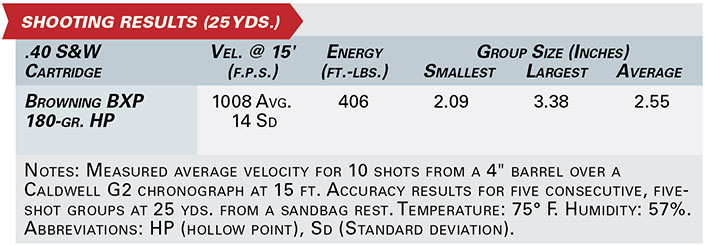
While aesthetics fall pretty low on my list of priorities, Browning’s new handgun lines certainly are visually appealing and distinctive. And uniform exterior finishes, when paired with adequately low standard deviation figures, tend to indicate uniformity in internal components as well—which is a comfort when it comes to ammunition designed to protect life and limb in close-quarters encounters.
Prices of BPT and BXP center-fire handgun loads will vary by chambering, with 50-round boxes of BPT running between $15 and $25, and 20-round boxes of BXP retailing for roughly $20—reasonable amounts given the obvious quality. Most shooters will agree that every new box of ammunition on the shelves is a good thing, and all indications point toward Browning’s new BPT and BXP lines being quality additions to the marketplace.
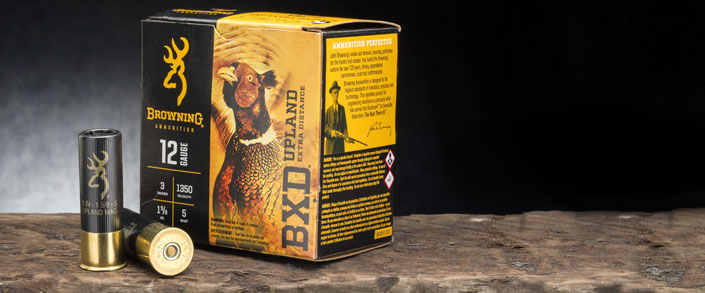
Browning Ammunition
Shotshells
By John Zent
At present you could argue that Browning’s best-known firearms are its shotguns, particularly in the target arena, where the Citori over-under is a global mainstay on skeet, trap and sporting clays ranges. Beyond that, the company’s BPS pump and Gold, Silver, Maxus and Auto-5 autoloaders are also highly regarded, and counted on for all sorts of hunting, competition and home-defense applications. Clearly it makes good sense to trade on that brand recognition and loyalty with a line of shotgun ammunition.

Though the black-hulled Browning shotshells are high-tech in many respects, they do benefit from one decidedly old-school process that top shooters still insist makes a difference. The lead shot used in the BPT and BXD Upland lines is produced in an actual shot tower. Fans of dropped shot contend that it is inherently rounder—and therefore flies truer and in denser patterns—than shot made from other methods. The latter type is becoming more prevalent, and given the costs involved, it’s unlikely we’ll see construction of new shot towers.
Browning’s most extensive category, shotshells, consists of three sub-brands—all, by the way, with non-reloadable hulls: BPT Performance Target; BXD Extra Distance Lead for upland; and BXD Extra Distance Steel for waterfowl. The BPT line includes 12-ga., 2¾" loads with 1 1⁄8 ozs. of No. 8 shot at 1145 f.p.s., 1 1⁄8 ozs. of No. 7s at 1200 f.p.s. and 1 1⁄8 ozs. of No. 7½s at 1300 f.p.s. In 16 gauge, there is a 2¾" load with 1 oz. of No. 8 shot at 1165 f.p.s., and in 20 gauge there is a 2¾" load with 7/8 oz. of No. 7½s at 1300 f.p.s. The BXD Upland line of lead shot loads includes a 12-ga., 3" load with 1 5⁄8 oz. of No. 5 shot at 1350 f.p.s. and two 2¾"" loads with 13⁄8 ozs. of either No. 5s or No. 6s. In 16 gauge, there’s a 2¾" load with 1 1⁄8 ozs. of No. 6 shot at 1295 f.p.s., and in 20 gauge there are two 3" loads with 1¼ ozs. of either No. 5s (see p. 95) or No. 6s at 1250 f.p.s., along with a 2 3/4" load with 1 oz. of No. 5s at 1300 f.p.s. The BXD Waterfowl line of steel shot loads includes three 12-ga. 3" load at 1450 f.p.s. with 1¼ ozs. of either BBs, No. 2s or No. 4s. There are also two 3½" loads with 1½-oz. payloads at 1500 f.p.s. with either BBs or No. 2 shot. There’s also a 20-ga., 3" load with 1 oz. of No. 2s at 1300 f.p.s.

Designed for serious competitors, the BPT loads feature high-antimony shot that is harder than the norm so that it resists deformation and stays rounder in its travel down the bore. The result is tighter, more consistent patterns and maximum impact effect for breaking targets. The smooth-skinned BPT hulls load and eject without a hitch, and, in order to keep costs in check, are not made for reloading. It’s also noteworthy that along with 12- and 20-ga. offerings, Browning has included a 16-ga. target loading, a rarity over the past 30 or 40 years. While many view the 16 as a relic, perhaps it’s not just coincidental that this year Browning also resurrected its classic Auto-5 Sweet Sixteen with a modernized inertia operating system. (Look for a review in an upcoming “Dope Bag.”)
BXD Upland ammunition also offers premium lead pellets, which, in this case, are hardened with nickel plating. That tough coating helps maintain roundness even at high velocities ranging from 1250 f.p.s. from a 20-ga. load to a 1350-f.p.s. heavyweight 12 gauge to blistering 1485-f.p.s. recipes in both 16 and 12 gauge. According to Browning, that helps to preserve downrange velocity and energy transfer, and the resulting shorter shot strings will mean more pellets on target, while requiring less lead to hit far-flushing pheasants and grouse. Although this ammo will do the job wherever upland birds fly, it should really shine in the challenging, and often bitter, conditions of late season on the Great Plains.
BXD Waterfowl shares the long-range mindset with its upland counterpart. More specifically, it too relies on high velocities and nickel-plated pellets—steel in this case—to ensure a hunter’s reach is both long and lethal. In these 20- and 12-ga. loadings the payloads ride in a wad designed expressly for long-range energy retention and pattern integrity, a bonus whether the birds are taxiing in or circling the far edge of the decoys.
 Patterning on paper at 40 yds. with a sampling from all three sub-brands showed uniform pellet distribution that met or bettered standard choke percentages. In particular, the BXD Waterfowl exceeded my pattern expectations. Inspection of shot charges from each of the patterned loads turned up very few flattened or out-of-round pellets, indicating stringent quality control to complement the overall shot quality and consistency. The pattern results are an indicator also of wad performance, and Browning says the waterfowl loads benefit from an “aerodynamically stabilized” wad. Though no wingshooting seasons were open during this initial test period, I was pleased with sporting clays scores fired with BPT loads in both 12 and 20 gauge.
Patterning on paper at 40 yds. with a sampling from all three sub-brands showed uniform pellet distribution that met or bettered standard choke percentages. In particular, the BXD Waterfowl exceeded my pattern expectations. Inspection of shot charges from each of the patterned loads turned up very few flattened or out-of-round pellets, indicating stringent quality control to complement the overall shot quality and consistency. The pattern results are an indicator also of wad performance, and Browning says the waterfowl loads benefit from an “aerodynamically stabilized” wad. Though no wingshooting seasons were open during this initial test period, I was pleased with sporting clays scores fired with BPT loads in both 12 and 20 gauge.
In this introductory year, Browning Ammunition shotshells are mostly focused on high-interest applications (plus paying court to 16-ga. shooters). The hunting loads are pegged to the premise that speed kills and kills at longer distances, thus reflecting the Utah-based firm’s popular Hell’s Canyon Speed line, though not directly part of it. The target loads are all about competing at high levels without overspending to do so. You can’t miss the familiar Buckmark embossed in gold on the black hulls or the Buckmark headstamp, but genuine performance markers are what make this a smart startup in the highly competitive shotshell market.
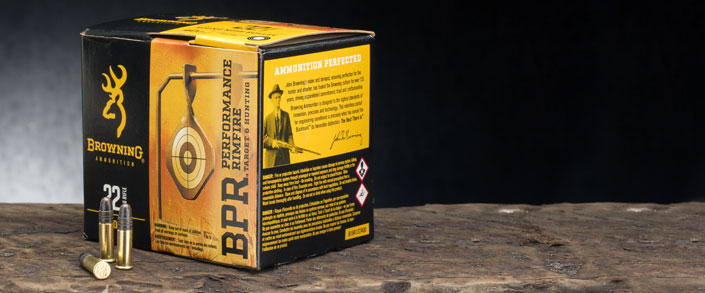
Browning Ammunition
Performance Rimfire
By Joseph L. Kurtenbach
Plinkers and varminters will rejoice that Browning’s foray into ammunition includes rimfire offerings, which are a welcome boost to a market with seemingly insatiable demand. Browning Performance Rimfire (BPR) was launched with three initial offerings, all .22 Long Rifle cartridges, including a 40-gr. round-nose load, a 40-gr. hollow-point and, perhaps most interesting of all, a 37-gr. load featuring a fragmenting bullet. As of this writing, the two 40-gr. loads were available for testing, and I hope the fragmenting load—company information touts its reliable four-piece segmented design—is soon to follow as it would seem to be ideal for dispatching small, non-edible pests.
The round-nose target load is exactly what I expected of value-priced .22 Long Rifle ammunition intended for high-volume range seasons. The 40-gr. lead bullets are finished with a black oxide coating to enhance lubricity and improve function in semi-automatic firearms. Though turbulence in the rimfire market over the past few years has caused local pricing and the supply of ammunition to vary greatly across the country, Browning suggests a retail of less than $0.07 per round. Similarly, the hollow-point cartridge is well-positioned at about $0.11 per round, and, being the fastest of the three loads, is a capable small-game hunting and high-velocity target round. Once available, the 37-gr. ammunition will carry a suggested price of about $0.15 per round. Visual inspection of the target and hollow-point loads revealed seemingly well-made ammunition, absent of visual flaws and generally uniform in appearance. And, of course, all BPR cartridges bear the iconic Buckmark, stamped on to the case head.

One thing I particularly like about the BPR line is its effective packaging. Each load-specific box, through its illustration and physical size, helps convey the nature and intended role of the cartridges contained therein. All continue the brand’s gold-and-black color scheme, but, for example, the round-nose target load is delineated by illustrations of bullseye-style targets, and it is only offered in a 400-round cardboard bulk pack—perfect for plinkers. The 40-gr. hollow point, on the other hand, is packaged 100 to a box, this time in a sliding-top plastic container, and will visually cue customers to its role as a bushy-tail buster with its squirrel-inspired design. And, though I haven’t seen it firsthand, it appears the fragmenting load will come in 50-round, prairie-dog-themed boxes—however, based on my experience with those rodents, I wouldn’t be surprised to see a larger bulk pack in the future.
At the range I evaluated the two 40-grainers for function and performance. Browning’s testing suggested the target ammunition would achieve velocities of 1255 f.p.s. and 1060 f.p.s. in rifles and handguns, respectively. Using a Ruger 10/22 rifle and a Smith & Wesson Victory pistol, fired over a Caldwell G2 chronograph at 15 ft., my results were very similar to company literature—10-shot averages were 1228 f.p.s. from 10/22 and 1098 from the Victory. The hollow-point load tested a bit below its published ballistics; Browning touts velocities of 1435 and 1305 f.p.s., rifle and pistol, but I clocked the load at 1367 and 1193 f.p.s. Testing conditions are enumerated in the notes of the accompanying table, and probably explain the difference in results. It’s worth mentioning that no malfunctions of any kind were encountered throughout testing, no small achievement for rimfire ammunition being used in semi-automatic firearms.

Digging a little deeper, I tested the loads for accuracy using the Ruger 10/22, a rifle known to produce 10-shot, 50-yd. groups ranging from about 0.75" to 1.5" with most types and brands of .22 Long Rifle ammunition. Full results can be found in the table, but both BPR loads performed admirably, providing accuracy characteristic of the rifle. The round-nose load produced two sub-1" groups and averaged 1.14" over five groups. The hollow points never cracked the 1" mark, but they did prove to be very consistent—with an overall average of 1.33", all five groups were within 0.15" of the average.
All in all, there is no downside to one of the biggest brands in the shooting and outdoor industry throwing its weight behind an ammunition line, particularly when that line includes appropriately priced, ballistically-sound .22 Long Rifle offerings.














